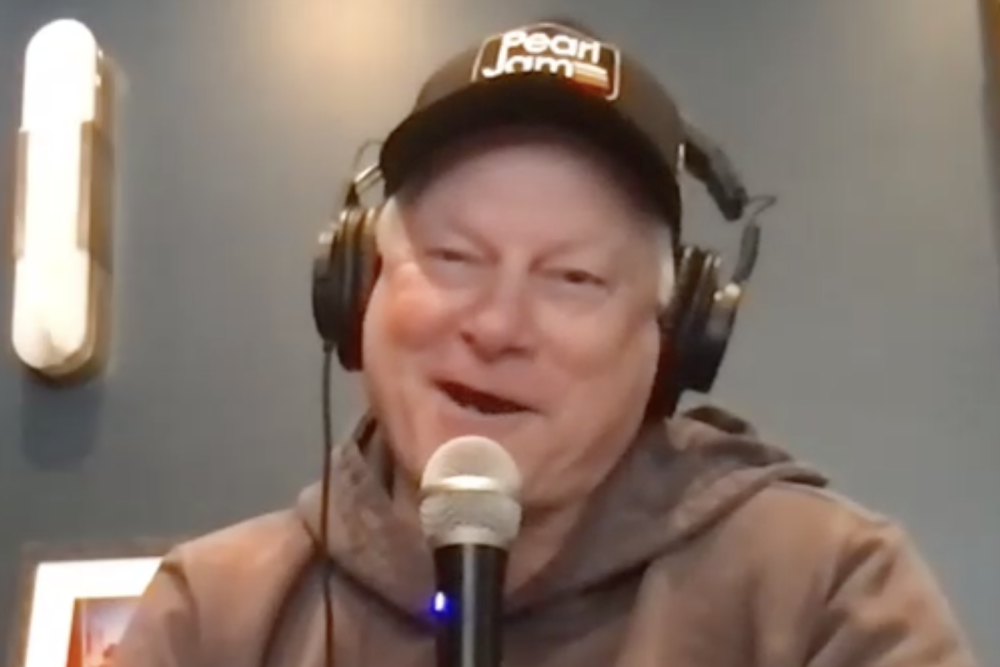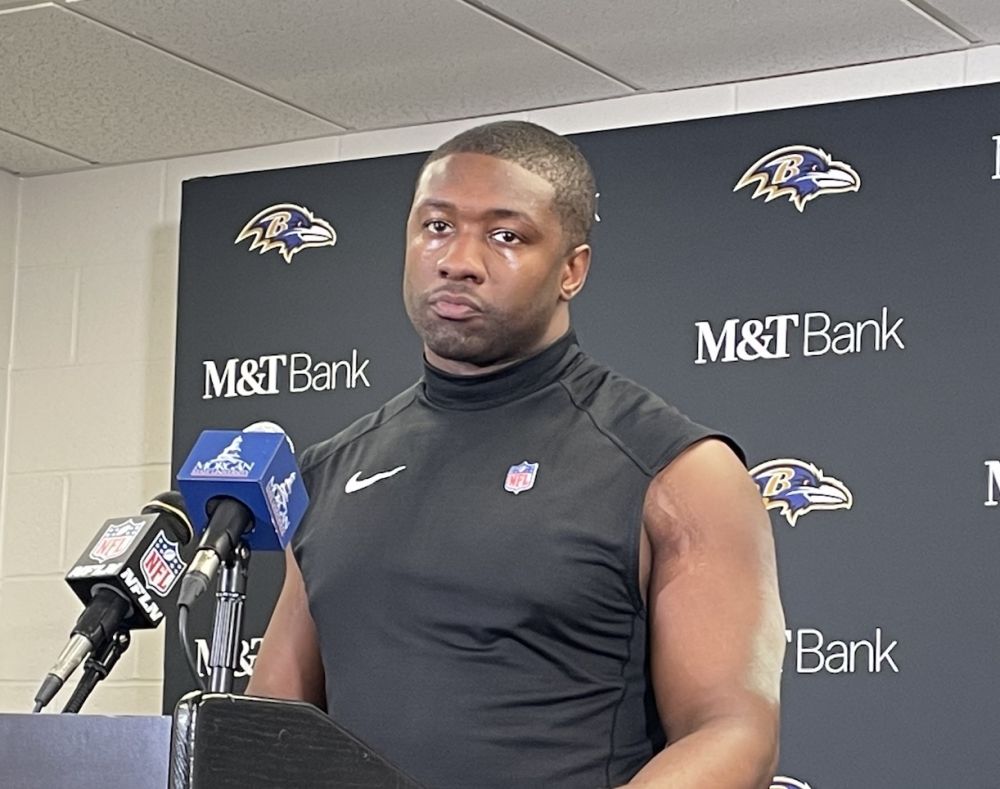Ogden wasn’t a sexy pick. He wouldn’t even play his natural position. He would line up as an extremely pricey left guard for the 1996 season to appease the already well-compensated Jones. It wasn’t the splash the Modells were looking for. The first-ever Draft Day party in Baltimore, with more than 2,000 in attendance, was also nonplused at the selection. The enormous Ogden took to the stage in New York’s Paramount Theatre to tower over commissioner Paul Tagliabue with a completely anonymous black and white hat with no logo, no attached color and no attached history. He spoke of his Washington, D.C., upbringing, his family’s excitement at the proximity of his football future and of his eagerness to play at the game’s highest level.

New head coach Ted Marchibroda, brought in from Indianapolis to deploy an aggressive offense, was looking for a weapon in the backfield out of the draft to go along with Vinny Testaverde and a stacked receiving arsenal including Andre Rison, Michael Jackson and Derrick Alexander. Always the company man, Marchibroda said “that’s the first block of the puzzle.”
In New York, I greeted Ogden as he left the stage and was awestruck by his enormous frame. He did a quick interview with my radio station, WWLG-AM, which was the flagship for the draft party, and quickly departed for the train station below at Penn Station for the three-hour ride to Baltimore. He struck me then as he strikes me now: the gentle giant. Ogden is polite, calm and huge – but devastatingly competitive on Sunday afternoons.
He left me with the hat he was wearing, the first-ever Baltimore Ravens cap. It came in handy nearly five years later, when black and white was in vogue for the 2000 AFC Championship Game in Oakland.
The coup of selecting two future Hall of Famers and two future World Champions in one day was only half complete.
The Ravens waited patiently throughout the day as they enjoyed the luxury of a second first-round draft selection that day in New York. They held selection No. 26.
There were 21 more players taken during the early afternoon and as the day wore on and name after name came off the board, all signs pointed toward an undersized inside linebacker from the University of Miami with the simplest of names, Ray Lewis.
To a man, everyone in the draft room that day wishes the story of how the future Super Bowl MVP and lightning rod for attention was drafted was more interesting. The truth is, there just wasn’t a ton of fanfare.
The Ravens had narrowed their selection down to two possible names: Lewis and a diminutive running back from Texas A&M named Leeland McElroy.
“We needed a linebacker, and he was far and away the highest guy on the board,” Savage now says. “Let’s not make ourselves out to be geniuses. If we had known then what we know now, we would have taken him with the No. 4 (pick). Twenty-three teams passed on Ray Lewis, including us.”
More interesting than the pick itself was how the pick was acquired.
Flash back to Draft Day 1995 at the Cleveland Browns facility in Berea, Ohio. There were a completely different set of characters in the war room. The Browns, just three months removed from a second-round playoff ouster by the Pittsburgh Steelers, had Michael Lombardi and then-coach Bill Belichick running their draft board. Savage and Newsome were no more than casual observers in the room, both relegated to quasi-coach, quasi-scout roles in the organization at the time.
The Browns were in control of the 10th pick in the draft, courtesy of a pre-draft trade/swap with the Atlanta Falcons involving running back Eric Metcalf.
The Browns had three names on their board: defensive lineman Mike Mamula, wide receiver Joey Galloway and tight end Kyle Brady. Mamula went to the New York Jets and Galloway had gone to Seattle before the New York Jets hit the board with the ninth selection. Because the Jets had tight end Johnny Mitchell in the fold, Lombardi and company were breathing easily, believing that Brady, their original preference anyway, would fall into their laps at the 10.
In a move by the Jets that would plot the Ravens’ fate the following year, Tagliabue moved to the podium and announced that Kyle Brady was a New York Jet.
The room went deadly silent for more than 30 seconds. Lombardi had no backup plan.
Finally, in a massive panic, Lombardi screamed, “We’ve got to get out!”
Lombardi began dividing up his war room into factions to begin calling other clubs to swing a deal. Because the brass felt that the picks between 10 and 30 were all of similar ability, any deal that netted future picks would be a good deal. Modell, Newsome, then-defensive coordinator Rick Venturi, Belichick and others made frantic calls while the clock ticked away. Pandemonium ensued. Other teams sensed the Browns’ panic and low-balled them with poor offers. Everyone in the NFL knew they were getting out of the slot. ESPN’s Gary Danielson later reported, erroneously from the Cardinals camp in Arizona, that Belichick was so angry that he had thrown a phone in the war room and knocked a TV off a stand. “Bill was pretty upset, and it was crazy in there for 10 minutes, but nothing got thrown,” an insider told me.
Quarterback coach Mike Sheppard was given the assignment of playing the point, relaying all of the incoming offers to the brass. He had a sophisticated chart of the past five drafts and trades that were made, detailing what value each slot in the draft had netted in previous years. After all was said and done and a half dozen offers were made, the Browns elected to swap their pick for San Francisco’s 1995 No. 1 (the 30th overall), a third (94), fourth (119) and their No. 1 pick in 1996. The Niners used the 10th pick of the 1995 draft to select wide receiver J.J. Stokes.
The Browns wanted to utilize the 30th pick later that day to select tight end Mark Bruener from the University of Washington. The Steelers beat them to the draw once again, taking Bruener with pick No. 27.
The Browns again were on the board at No. 30 without a consensus, without a clue. They selected linebacker Craig Powell from Ohio State, who was to sit behind starter Carl Banks and learn the game. A typical Belichick defensive guy – long on speed and size – Powell was discussed just one time among scouts before being drafted. Long-time Browns scout Ernie Plank – the man who drafted Joe Montana in San Francisco and perhaps the most respected man in the room – had him rated as a potential fourth-round choice but was never asked his opinion before Lombardi sent in the pick.
From the first day of rookie mini-camp in Berea, Ohio, the following week, it was apparent Powell lacked the instinct to play in the NFL. Powell never played a down as a starter for the Browns or the Ravens and was out of the league by 1997.
That day, April 15, 1995, was the worst thing that could have happened to the Cleveland Browns but the best thing that had happened for the Baltimore Ravens.
Ozzie Newsome and Phil Savage had seen the carnage of a draft war room that was divided and in disarray. Held unaccountable for any of the proceedings of that debacle, they learned. Holding the future No. 1 pick of 1996 that became Ray Lewis, they capitalized.
“Beginners luck,” Savage likes to quip, in regard to going two-for-two with all-but-sure-fire Hall of Famers in their first four hours of the NFL draft experience.
To understand the philosophy of the Ravens’ draft history and its process, is to understand Newsome and Savage, a pair of soft-spoken, humble Alabama boys and the unquestioned architects of the first half-decade of Ravens football.
Savage cut his teeth as a quarterback at Division III Sewanee (Tenn.), a small Southern school that stressed academics and fielded an almost intramural football team. An NFL quarterback, he was not going to be. Part Forrest Gump – he was born, raised and still lives in Mobile, Ala. – and part Richie Cunningham, Savage landed a job as a graduate assistant at his beloved University of Alabama, working under legendary offensive coordinator Homer Smith in 1988 and ‘89. From there he went to UCLA as a tight ends coach, completely skipping the middle trail of small colleges. He quickly caught the eye of future San Diego Chargers coach Mike Riley and got his foot in the door of the NFL by taking a job working with the World League of American Football in 1990 with the San Antonio Riders. In March of that year, he got his big break when he interviewed and won a job as a quality control coordinator for the Cleveland Browns.
“The most important thing that I learned in the first year some guys never understand,” Savage said. “Football was what I wanted to do, but it was not going to be an easy life. You had to accept that. You and your family are going to be fired, transplanted, moved, demoted – you name it. And the fans can be cruel. In the real world, if you botch a sale, you wake up the next day and move on to the next sale. In football, if you botch a play that costs you a game, you’re gonna get booed and you’re gonna get fired.”
But Savage loved the life.
For four years he moved from the offensive side of the ball to the defensive side. He did film breakdowns, tendency studies, scouting reports, led the scout team and got to work with some of the game’s brightest minds.
“I wasn’t even 30 years old and I had worked with Homer Smith, Bill Belichick, Scott O’Brien, Gary Tranquill, Nick Saban – guys who really were geniuses when it came to football,” Savage said.



























